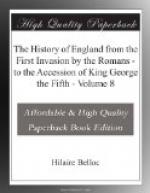For this purpose Herbert (now[a] created earl of Glamorgan) was furnished, 1. with a commission to levy men, to coin money, and to employ the revenues of the crown for their support; 2. with a warrant[b] to grant on certain conditions to the Catholics of Ireland such concessions as it was not prudent for the king or the lieutenant openly to make; 3. with a promise on the part of Charles to ratify whatever engagements his envoy might conclude, even if they were contrary to law; 4. and with different letters for the pope, the nuncio, and the several princes from whom subsidies might be expected. But care was taken that none of these documents should come to the knowledge of the council. The commission was not sealed in the usual manner; the names of the persons to whom the letters were to be addressed were not inserted; and all the papers were in several respects informal; for this purpose, that the king might have a plausible pretext to
[Footnote 1: Clarendon Papers, ii. 201.]
[Sidenote a: A.D. 1645. Jan. 2.] [Sidenote b: A.D. 1645. March 12.]
deny their authenticity in the event of a premature disclosure.[1]
Glamorgan proceeded on his chivalrous mission, and after many adventures and escapes, landed in safety in Ireland. That he communicated the substance of his instructions to Ormond, cannot be doubted; and, if there were aught in his subsequent proceedings of which the lord lieutenant remained ignorant, that ignorance was affected and voluntary on the part of Ormond.[2] At Dublin both joined in the negotiation with the Catholic deputies: from Dublin Glamorgan proceeded to Kilkenny, where the supreme council, satisfied with his authority, and encouraged by the advice of Ormond, concluded with him a treaty,[a] by which it was stipulated that the Catholics should enjoy the public exercise of their religion, and retain all churches, and the revenues of churches, which were not actually in possession of the Protestant clergy; and that in return they should, against a certain day, supply the king with a body of ten thousand armed men, and should devote two-thirds of the ecclesiastical revenues to his service during the war.[3]
[Footnote 1: See the authorities in Note (A).]
[Footnote 2: See the same.]
[Footnote 3: Dr. Leyburn, who was sent by the queen to Ireland in 1647, tells us, on the authority of the nuncio and the bishop of Clogher, “that my lord of Worcester (Glamorgan) was ready to justify that he had exactly followed his instructions, and particularly that concerning the lord lieutenant, whom he had made acquainted with all that he had transacted with the Irish, of which he could produce proof.”—Birch, Inquiry, 322. Nor will any one doubt it, who attends, to the letter of Ormond to Lord Muskerry on the 11th of August, just after the arrival of Glamorgan at Kilkenny, in which, speaking of Glamorgan, he assured him, and through him the council of the confederates,




